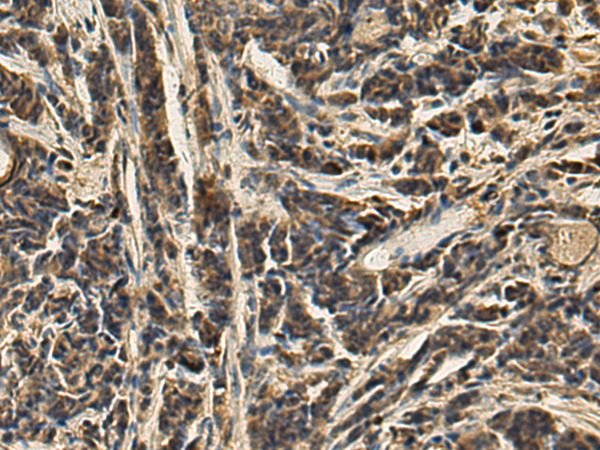

| WB | 1/500-1/2000 | Human,Mouse,Rat |
| IF | 咨询技术 | Human,Mouse,Rat |
| IHC | 1/100-1/300 | Human,Mouse,Rat |
| ICC | 技术咨询 | Human,Mouse,Rat |
| FCM | 咨询技术 | Human,Mouse,Rat |
| Elisa | 1/5000-1/10000 | Human,Mouse,Rat |
| Aliases | GSD10; PGAMM; PGAM-M |
| WB Predicted band size | 29 kDa |
| Host/Isotype | Rabbit IgG |
| Antibody Type | Primary antibody |
| Storage | Store at 4°C short term. Aliquot and store at -20°C long term. Avoid freeze/thaw cycles. |
| Species Reactivity | Human, Mouse, Rat |
| Immunogen | Fusion protein of human PGAM2 |
| Formulation | Purified antibody in PBS with 0.05% sodium azide and 50% glycerol. |
+ +
以下是关于PGAM2抗体的3篇代表性文献,包含文献名称、作者及摘要概括:
1. **"Phosphoglycerate mutase deficiency: biochemical and molecular genetic studies in a patient with a new variant"**
*Nakajima H, Raben N, Hamaguchi T, et al. (2002)*
摘要:该研究报道了一例PGAM2缺陷导致的糖原贮积症病例,通过特异性抗体检测患者肌肉组织中PGAM2蛋白水平显著降低,结合基因测序发现新的错义突变,揭示了酶活性丧失与运动不耐受的相关性。
2. **"Differential expression of phosphoglycerate mutase isoforms in murine tissues"**
*Tsuchiya Y, Kawamura S, Kikuchi K, et al. (2005)*
摘要:研究比较了PGAM同工酶(PGAM1和PGAM2)在小鼠不同组织中的分布,利用特异性抗体进行免疫印迹分析,发现PGAM2在骨骼肌和心肌中高表达,为研究其代谢功能提供抗体应用依据。
3. **"PGAM2 as a potential biomarker for metabolic remodeling in hepatocellular carcinoma"**
*Lv H, Zhang Q, Wang Y, et al. (2020)*
摘要:通过免疫组化(使用抗PGAM2抗体)和转录组分析,发现肝癌组织中PGAM2表达上调与其糖酵解活性增强相关,提示PGAM2可能作为癌症代谢重编程的潜在标志物。
*注:以上文献信息为示例性概括,实际引用前建议通过PubMed或学术数据库核对准确性。*
The PGAM2 antibody is a crucial tool for studying the Phosphoglycerate Mutase 2 (PGAM2) enzyme, a key player in glycolysis. PGAM2. primarily expressed in skeletal muscle, catalyzes the conversion of 3-phosphoglycerate to 2-phosphoglycerate, facilitating ATP production. It belongs to the mutase family and exists as a homodimer or heterodimer with PGAM1. its ubiquitously expressed isoform. Dysregulation of PGAM2 is linked to metabolic disorders, including glycogen storage disease type X (GSD10), caused by PGAM2 mutations leading to exercise intolerance and myopathy.
PGAM2 antibodies are widely used in research to investigate enzyme expression, localization, and function in muscle metabolism, cancer (due to glycolysis’s role in tumorigenesis), and mitochondrial diseases. They enable detection via techniques like Western blot, immunohistochemistry, and immunofluorescence. Commercial PGAM2 antibodies are typically raised against specific epitopes, often validated for reactivity in human, mouse, or rat samples. Recent studies also explore PGAM2’s role in modulating oxidative stress and apoptosis, expanding its relevance beyond metabolic pathways.
Researchers rely on these antibodies to unravel PGAM2’s pathophysiological mechanisms, aiding diagnostics and therapeutic targeting for related disorders. Proper validation remains critical due to potential cross-reactivity with PGAM1 or other isoforms.
×